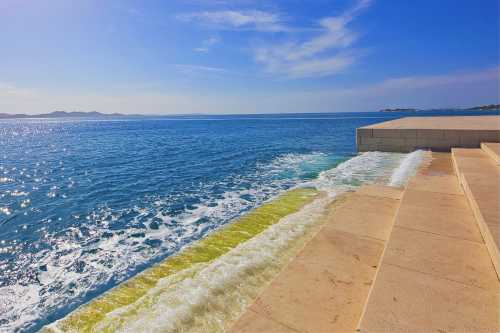Popular Trip Moments
【Grand Balkan Peninsula Tour in Europe, Part 25: Zadar's Symphony of Time | The beauty of the Balkan Peninsula is on another level | Zadar Croatia | Where the Sea Sings and the Sun Dances – Welcome to Zadar | Fragments of a European Journey 🩶 | A painting on a large canvas | Travel insights from Zadar | A diamond-like exhibit found in Zadar | Hvar in search of romance✨ | No one can resist the fairy-tale charm of Zadar! | "Enchanted Croatia: A Romantic Encounter with Medieval Towns and Azure Coastlines!" | Church of St. Simon | 8-day in-depth tour guide for Croatia and other countries | Discovered through numerous excavations | Walking through the old town | Rather than hiking boots that are too heavy | Traditional Croatian sauce Ajvar | Croatian sweets recommendations | Glass Museum in Zadar Old Town | Moments given by nature | Before boarding the plane | Products using truffles | If you want to enjoy a beautiful sunset | With truffle | For passengers waiting for their flight | Cool Radler | MALVAZIJA DEKLIC Croatian wine recommendation | There is a little bit of space left | At the end of the trip | To a museum that is a space for everyone
Recommended Attractions at Popular Destinations
Bangkok attraction near me | Manila attraction near me | Tokyo attraction near me | Taipei attraction near me | Hong Kong attraction near me | Seoul attraction near me | Kuala Lumpur attraction near me | Los Angeles attraction near me | Shanghai attraction near me | New York attraction near me | Shenzhen attraction near me | Osaka attraction near me | Singapore attraction near me | London attraction near me | Guangzhou attraction near me | San Francisco attraction near me | Beijing attraction near me | Macau attraction near me | Bali attraction near me | Jakarta attraction near me | Paris attraction near me | Ho Chi Minh City attraction near me | Istanbul attraction near me | Phuket attraction near me | Chicago attraction near me | Seattle attraction near me | Toronto attraction near me | Orlando attraction near me | Cebu attraction near me | Chiang Mai attraction near me
Popular Attractions
Hukou Scenic Area | Pangkor Laut Island | Burj Khalifa | Disneyland Paris | Zoo Negara Malaysia | Sheikh Zayed Grand Mosque | The View at the Palm | Sayram Lake | Mausoleum for former Turkish leader | Hollywood | The Dalian Coastal National Geopark | National Stadium | Holy Trinity Cathedral of Tbilisi | Munch | Dubai Crocodile Park | Al Montazah Parks | The Rinx | Shri Kashi Vishwanatha Swamy Temple | Powell Butte | Tubo Park | Bar changay waterfall | Masjid Jami Al-Amin | Comunidade Monte Carmelo Church | Campo 1 di tennis | Antakya Atlı Spor Kulubu | Heimatverein Aue | View of Alefkandra (Little Venice) | Komodo National Park | Yu Garden | Sky Views Observatory
Popular Restaurants in Zadar
Konoba Bonaca | Corte Vino & More | Gusti IX | Tramonto Restaurant | Beach Bar Bamboo | Pizzeria Šime | Coffee & Cake - Kavana CENTAR | Proto Food&More | Zlatni Vrt | Pasta & Svasta | Restaurant Spajza | Lungo Mare | La Famiglia | Harbor | Restaurant Galija | Bistro Gušti | Urban Piknik | Bon Appetit Restaurant | Salsa Rossa | Restaurant City Laguna Zadar | Hedonist Dining & Hangout | Restaurant Niko | Illy Bar | Konoba Dalmacija | Monster Kebab | Tri Bunara | GRICKO | Zadar Jadera Traditional Restaurant | 2Ribara Restaurant | be wok
Popular Ranked Lists
Top 15 Best Things to Do in Gold Coast | Popular Must-Visit Restaurants in Yangzhou | Popular Luxury Hotels Near Hohnstein | Top 12 Best Things to Do in Province of Malaga | Popular Local Restaurants in Bangkok | Top 19 Local Restaurants in Venice | Popular Must-Visit Restaurants in Madrid | Popular Must-Visit Restaurants in Bruges | Popular Luxury Hotels Near Kiso Town | Top 14 Local Restaurants in Weihai | Popular Luxury Hotels Near Gmina Grunwald | Top 3 Premium Hotels in Yamagata Prefecture | Popular Best Things to Do in Iraq | Popular Must-Visit Restaurants in Milan | Popular Premium Hotels in Hatsukaichi | Popular Best Things to Do in Lebanon | Popular Must-Visit Restaurants in Frankfurt | Popular Must-Visit Restaurants in Florence | Popular Best Things to Do in Gordes | Popular Must-Visit Restaurants in Macau | Top 5 Best Things to Do in Costa Rica | Popular Luxury Hotels Near Borgo a Buggiano | Popular Must-Visit Restaurants in Fukuoka | Top 4 Best Things to Do in Belarus | Popular Luxury Hotels Near Sellano | Popular Must-Visit Restaurants in Songyang | Popular Luxury Hotels in Jozankei Onsen | Popular Premium Hotels in Laikipia | Popular Premium Hotels in Aisne | Top 11 Best Things to Do in Antarctica
Payment Methods
Our Partners
Copyright © 2025 Trip.com Travel Singapore Pte. Ltd. All rights reserved
Site Operator: Trip.com Travel Singapore Pte. Ltd.
Site Operator: Trip.com Travel Singapore Pte. Ltd.































